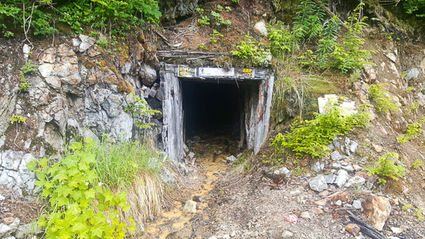Sampling discovers new Porter silver veins
North of 60 Mining News – September 21, 2018
Last updated 9/25/2020 at 6:38am

StrikePoint Gold Inc.
This adit leads into the historic Silverado Mine on StrikePoint Gold's Porter property just outside of Stewart, B.C.
StrikePoint Gold Inc. Sept. 17 reported samples with as much as 1,432 ounces per metric ton silver, 16.9 grams per metric ton gold and 3.57 percent copper in the first round of assay results from surface sampling at the Porter silver project on Mount Rainy about 2.5 kilometers (1.5 miles) southeast of Stewart, British Columbia.
Three historic mines are found on the recently expanded Porter property – Silverado, which is on the mountain facing Stewart; Porter; located about 2,000 meters southeast, on the opposite side of Mount Rainy; and Melvin Adit, a small historical mine opening about 1,000 meters north of Porter.
Since the initial discovery of high-grade silver on Mount Rainey in the early 1900s, most of this work was focused on the Prosperity-Porter Idaho veins, where mineralization is hosted in six dipping parallel shear zones tracked on surface for 200 meters and 1,000 meters down dip with widths between two and 13 meters. Roughly 27,123 metric tons of ore averaging 2,542 grams (73.8 ounces) per metric ton silver and 1 g/t gold was mined from the vein system between 1929 and 1931, producing roughly 2.2 million oz of silver.
According to a resource estimate prepared in 2012, Porter Idaho has 394,700 metric tons of indicated resource averaging 868 g/t silver (11 million oz) silver, 3.37 percent lead and 1.41 percent zinc; plus 88,900 metric tons of inferred resources grading 595 g/t (1.7 million oz) silver.
The initial results from StrikePoint's 2018 sampling represent new discoveries of veins and other mineralized features from outside of the historical resource area and support targeting of the two diamond drill rigs currently operating on the project.
The best sample so far, X958002, contained 44,546 g/t (1,432 oz/t) silver.
Found in a gully above the mine portals at the historic Silverado mine, this float sample is assumed to have come from an area where ice has retreated in recent years. While not collected from outcrop, this galena-rich quartz-vein specimen was collected where the topography consists of narrow, steep-sided gullies. Given the topography, StrikePoint geologist believe the specimen must have originated from a local vein along the steep slopes above where it was found.
Along with silver-bearing galena, this sample also contained chalcopyrite, which resulted in a copper value of 3.57 percent. StrikePoint said this copper mineralization is consistent with field observations of copper minerals associated with higher-grade silver. The grab sample also contained 3.25 g/t gold.
Sampling on the Porter side of Mount Rainy also turned up bonanza grade silver.
One sample, X957727, collected from a galena-rich quartz vein about 200 meters west of the historic Porter mine contained 25,981 g/t (835 oz/t) silver.
This vein, which is up to 40 centimeters thick, would have historically been obscured by late-lying snow cover.
An additional seven samples were collected along a 100-meter strike length of this vein returning assays ranging from 203 to 1,390 g/t silver. Additional assays from systematic sampling of this vein beyond the historical Porter resource are pending.
Another sample from even further outside the historical resource, X956011, returned 1,330 g/t silver and 16.9 g/t gold.
This sample of newly discovered Silver Key vein is 800 meters west of the nearest mine portal. StrikePoint said this new vein, which would have previously been obscured by the glacier, may be a westerly continuation of the vein sample X957727 was collected from, and field investigation is ongoing.
The presence of gold in the sample is in line with a general trend whereby the galena-rich silver veins seem to be passing into more arsenopyrite-rich gold veins to the west of the historical workings.
Sample X958358, collected from a gossanous zone south of Porter returned 9,500 g/t silver and 2.6 g/t gold.
The significance of this sample and the zone it was collected from is they are south of Big Rig Fault, a structure that was previously assumed to cut off the silver mineralization and so formed the southerly extent of the resource. The discovery of this sample shows that there is potential for the veins to have been offset by the fault and continue further south into the valley.
Sample X956556, collected from a group of parallel veins discovered on StrikePoint's recently acquired Handsome Jack property, returned 8,900 g/t silver.
These veins are to the east of the outermost veins included in the historic resource. They are comprised of swarms of smaller veins up to twenty centimeters wide within a five-meter zone and would have been overlooked by the original miners working the Porter Mines. These veins represent a new style of mineralization that could add bulk to a new resource, but also help to strengthen the idea that veins are not restricted to the original Porter project.
Besides the high-grade samples, StrikePoint Gold Vice President of Exploration Andy Randell told Mining News that this year's field work is finding evidence of an apparent silicified cap that forms the peak of Mount Rainey, which blocked mineralized fluids from rising to the top of the mountain.
StrikePoint says this cap rests on top of a "scoop shaped" fault like those seen at Ascot Resources' Premier Mine, roughly 17 kilometers (11 miles) to the northwest. This lithological unit preventing veins from reaching the surface would help explain the lack of mineralization at the peak. Instead, the mineralizing fluids have the potential to track parallel to these faults forming the flat veins noted in the historical resource.
StrikePoint said this cap also strengthens the idea that mineralized veins could be continuous between Porter and Silverado and are just masked by this geological phenomenon.
Previous explanations of the geology of the Porter and Silverado mines are being found to be oversimplified and the geological team has spent significant time mapping and sampling across the entire project area.
Additional samples from field sampling are currently at the lab and the program is expected to continue as long as good ground conditions prevail.
StrikePoint also has two drills turning on the property. To find out more about the drill program and recent expansion to the Porter property see Strikepoint grows high grade silver project, published in the Sept. 14 edition of North of 60 Mining News.

Strata Geodata Services
Geologist Ohi Akpengbe is part of the team that carried out StrikePoint Gold's 2018 sampling program at the Porter Idaho silver property.
–SHANE LASLEY







Reader Comments(0)